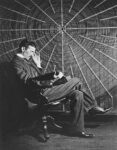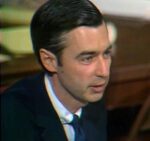Throughout his long and memorable life, Thomas Jefferson enslaved people. Let’s get that out of the way at the onset. He was born into a system built upon slavery, lived within an economy dependent upon it, and though he wrote numerous impassioned condemnations of that system, continued to practice it, uncertain as to how it could be ended without disaster. He even predicted how that disaster would unfold. Yet, he recognized that abrupt emancipation would be as disastrous to the former slaves as it would be to the former slaveowners.
Whether he took slaves as his concubines and fathered children with them, despite the laws in Virginia proscribing such acts, remains a subject of debate. DNA testing in the late 20th century, as well as the records of the era, do not offer an answer that conclusively ends all debate. The debate is an impassioned one, fueled by the prejudices and opinions of an era far removed from the one in which the participants lived. Yet despite Jefferson’s faults, perceived, real, or imagined, there is no dispute that few individuals had a greater impact on American history, many in ways well known and others in ways largely forgotten.
Throughout his long life, Thomas Jefferson was an innovator. When he saw something that could be improved upon, he took steps to do so, often after long and careful study. He took the classic architecture of history, altered it slightly to his own tastes, and created many of the modern designs now referred to as classical, including the US Capitol, the White House, the Capital of Virginia in Richmond, and his own homes of Monticello and the less well-known Poplar Forest. The latter was one of the first octagonal houses ever built in North America.
Jefferson’s innovations were both large and small, public and private, yet all continue to influence modern life. So, cast aside for a time condemnations and outrage and consider some of the less well-known ways in which Thomas Jefferson made a lasting impact during his own time and in posterity.
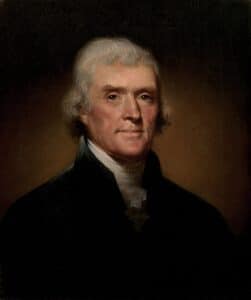
The Office Copier
Thomas Jefferson’s professional life, whether at his farms or in one of the many political offices he held over his long career, was largely spent in the review or preparation of correspondence. Even in his retirement in Monticello, he spent a minimum of five hours every day laboring over his papers, letters, diaries, logbooks, account books, and other forms of what must have seemed an unending stream of paperwork. His labors were increased by the need to retain copies of his work, in part due to the unreliable mail service of the time and in part to either refute or confirm the reports of others regarding his statements and avowed positions on issues.
Throughout his career, Jefferson employed secretaries whose duties chiefly consisted of assisting him with such mundane details. One of these was Meriwether Lewis, whose long service Jefferson rewarded with the command of the Corps of Discovery in 1804. That mission became known to history as the Lewis and Clark Expedition. The majority of his secretaries gained no such fame, however, laboring unknown until forgotten by time.
In 1783, Jefferson was in Paris, sent there by the Confederation Congress to serve as Minister to France, replacing Benjamin Franklin. Jefferson paid his respects to Dr. Franklin upon his arrival, and there saw a machine that the doctor used routinely to make copies of his personal documents and letters saved in his own hand. The copies were made on a machine that resembled a printing press, recently invented in London. Franklin had been a printer in England years before the unpleasantries that separated the mother country from colonies and had maintained many of his contacts there, which gained him access to the newly invented machine.
Its use required both special ink and paper, both of which had to be purchased, at considerable expense, from its inventor. Jefferson was intrigued with the device, writing to Madison and others in America of its value in producing true copies, yet he was not ready to accept it fully. Simply put, it was too large for practical use in a private office.
The machine required the user to produce a document to be copied using the special ink, which was thicker than normal and dried more slowly on paper that was far thinner than that generally used at the time. The document was then placed in the machine, a second page placed on top, and the two squeezed together by the mechanical press. The action produced a mirror image of the original, which was then deciphered by reading the reverse. Though it produced a true copy, the image was blurred by the spreading of the ink under pressure. For someone with small handwriting, like Jefferson, the result was often indecipherable for all but the originator. Still, Jefferson was enamored with the device.
In 1786, Jefferson visited John Adams in London and took the time to view one such copying machine. He obtained the dimensions of the device and, upon return to Paris, had a local carpenter build a smaller version of the machine. The resulting device was considerably smaller, making it easier to move with its owner when relocating his office. Jefferson had, albeit inadvertently, created the first portable copier, which continued to serve him and multiple officers of his and later governments for the rest of his career.
The Confidential Copier
In 1804, Jefferson ordered two additional copying devices he called a “polygraph machine.” Today, a polygraph is a machine more commonly referred to as a lie detector. Jefferson’s polygraph was a machine devised to produce two copies of the same document as it was being written. Two pens were connected via a system of rods and pulleys, allowing the pen manipulated by the machine to follow exactly the pen used by the composer. It produced, in the writer’s hand, an exact copy of what was written. Invented by an Englishman who had moved to Philadelphia named John Hawkins, Jefferson saw the machine demonstrated there and was so impressed he called the device “…the finest invention of the present age”.
Jefferson’s view was shaped, in large part, because the true copy could be created without additional labor by the author and without needing to rely on the labors and discretion of a secretary, an indication that as his political career advanced, so had his desire for complete secrecy in some areas. He had polygraphs installed in the White House and his home at Monticello. By 1809, when he retired from office, Jefferson wrote to a friend that he had discarded the use of the copying machine in favor of the polygraph, “…the polygraph has spoiled me for the old copying press the copies of which are hardly ever legible”. Jefferson continued using the polygraph for the rest of his life, making frequent references to it in correspondence and keeping machines at his homes at Monticello and Poplar Forest.
Jefferson’s experience with the copying machine and subsequent adoption of the polygraph offers an interesting insight into his character. He was quick to adopt new technology when he found it likely to improve what was, to him, modern life. He was equally quick to replace it when what he perceived as new, improved technology emerged.
Office Furniture
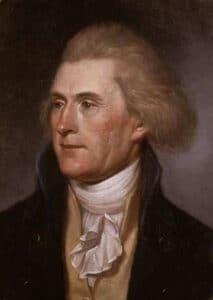
Machines to reproduce his correspondence were not the only area of concern for Thomas Jefferson when equipping the modern office. A true polymath, Jefferson maintained lifelong interests in an amazingly diverse number of subjects, including their history, their present, and their potential future. His desk was often cluttered with books from which he derived arcane information. For example, he studied the Bible to derive information regarding farming from the ancients. Books scattered across a desk or tabletop were difficult to keep sorted, with immediate reference to the salient points he wished to review.
To ease his ability to refer to books and documents, Jefferson devised a revolving bookstand. Jefferson was a virtuoso violinist and enjoyed playing with other musicians. His bookstand likely was inspired by the music stands where the musicians kept their scores as they played. Jefferson’s book stand, which he kept at the White House while in office and at Monticello in retirement, contained five separate racks to hold open volumes, with pins to keep them open to the desired page. The bookstand offered the ability to rapidly refer to each volume, rotating it in either direction as necessary, rather than flipping through the volumes on the otherwise cluttered desk. Jefferson could thus quickly refer to his New Testament in Greek, Latin, and English, all languages with which he was intimately familiar, as he attempted a more accurate interpretation of the Bible in the 1820s.
More than one revolving bookstand was likely resorted to in his Monticello study, with another holding farm records, yet another, books of classical antiquity, Homer and Plato, for example, alongside works of John Locke and Voltaire. The man was a true polymath.
Another piece of office furniture that Jefferson favored and developed was one created in part due to the need to light one’s workspace with a candle or oil lamp. He also found it inconvenient to continually reorient his chair when meeting with numerous people at once. His solution was what is today considered so normal as to be scarcely given a thought. Jefferson equipped his offices and private studies with one of the earliest examples of the swivel chair.
Many sites claim Thomas Jefferson invented the swivel chair, which he called a “revolving Windsor chair,” though that seems unlikely. He undoubtedly improved it, as records at Monticello show. Jefferson likely encountered the swivel chair in Philadelphia in 1776, and when he returned to his home, he brought it with him. Over the subsequent years, it was modified several times in Monticello’s own carpentry shops, including the addition of a writing pad mounted on the right arm.
Whether he invented the swivel chair or had it built for him by a Philadelphia furniture maker, as some claim, is immaterial. There is no doubt that he was one of the earliest users of such a piece of furniture and that he adapted the design to suit his own purposes over the years is entirely within his character. The polygraph, copying machine, swivel chair, and book rack are all available for inspection at Monticello today, samples of his fascination with even the simplest of technologies.
The Modern Farmer
Thomas Jefferson was a firm believer in education, most of all through continuing education through experience and observation. Though he was schooled in the classics and mathematics and read in the law, he was first and foremost an agriculturist. At his Virginia farms, he was constantly experimenting with new crops, introducing new plants to Virginia from Europe, Africa, and the islands around the world. He experimented with vineyards, nuts from Spain and North Africa, citrus fruits, olives, and new types of pest-resistant grains. During his sojourns in Europe, he observed evolving methods of farming in France and Italy. Among his observations recorded in the 1780s and 1790s in France and Spain were what he perceived as the failings of the plows then commonly in use.
Jefferson found the plows to be inefficient in the manner in which they turned over the soil as they were forced through the ground by animal power, leaving behind irregular furrows with lengths so poorly turned they were unable to receive seed. He attributed their shortcomings to a poorly designed moldboard. As a plow is driven through the soil, a cutting blade and divider called the coulter, split the soil. The moldboard then thrusts the soil upwards and over, creating a furrow of “turned” soil. In 1788, Jefferson recorded in his notes his perceived deficiencies in the design then in vogue, and his suggestions for correcting them.
Jefferson began experimenting with a new moldboard of his own design at Monticello in the 1790s and, by mid-decade, boasted of its success to Scottish statistician, agriculturist, and fellow polymath Sir John Sinclair. In 1810, after Jefferson retired from the White House, Monticello’s armory began manufacturing the moldboard from iron, as previously it had been made from wood. Jefferson was pleased with the simplicity of his design, which made it possible for even unskilled artisans to reproduce it with relative ease, and made the design available to any who asked.
It was probably Jefferson’s one true invention, though he chose not to pursue a patent for the device. Like George Washington, who had invented a new form of seed drill for use in planting but refused to patent it, Jefferson believed that innovations in agriculture belonged to all who sought to pursue the difficult profession of farming.
The Modern Gardener
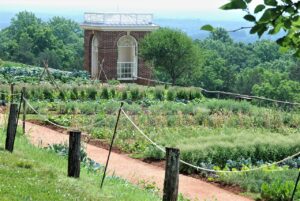
Jefferson’s extensive gardens at his homes at Monticello and Poplar Forest played an important role in providing fruits, vegetables, and herbs for consumption. Yet they also served as experimental laboratories. Jefferson flower gardens grew ornamental plants for decoration but also plants used to develop medicines, to control pests organically, and to develop hardier species resistant to disease and pestilence. Most contemporaneous gardens grew native species, content to harvest food for the table and flowers for decoration. Jefferson pushed the envelope to expand what could and couldn’t be cultivated in America.
His fruit gardens contained over 300 species, some native to Virginia, some imported from Asia, the Pacific Islands, Africa, Europe, and Central and South America. His gardens were designed to take advantage of the orientation of their grounds in relation to rainfall, drainage, and wind direction, as well as periods of sunlight and shade most beneficial to the plants.
The gardens at the main house at Monticello were not the only producers of fruit and vegetables for the table. Jefferson’s slave quarters had extensive gardens of their own, which were used entirely to grow food, rather than for experimentation. Records at Monticello include those of Jefferson purchasing fruits and vegetables from his enslaved people, paying for them in cash or credit. Produce purchased by Jefferson, his wife Martha, and his daughters included potatoes and sweet potatoes, cabbages, beans, tomatoes, and fruits, including melons, berries, and others. Both chickens and eggs were purchased from enslaved people on the estate, particularly when large numbers of guests were visiting. Monticello’s enslaved peoples were also able to sell their produce at markets in Charlottesville, as well as other plantations.
In this activity, Jefferson was again an innovator, as he paid his enslaved peoples for both goods and services, despite the frequent protests from neighbors and planters from other states. Jefferson also hired out enslaved laborers to other farms and work projects, including during the construction of the Capitol, State, and War Building, and White House, as well as workers who contributed to the construction of the University of Virginia. He allowed them to keep their wages and to use them to purchase, among other things, their own freedom or that of family members.
The Power of the Presidency
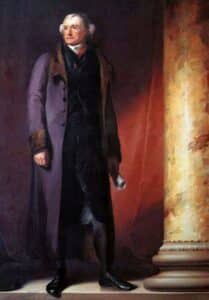
Both Jefferson’s predecessors in the Presidency, George Washington and John Adams, believed the powers of the office were limited to those specified by the Constitution. Jefferson served in Washington’s Administration as Secretary of State and largely agreed with that sentiment. As his immediate predecessors’ administration unfolded, Jefferson grew to support that view ever more strongly, supporting the idea of limiting the power of the Presidency and the federal government in favor of the states’ governments. Jefferson grew to believe the more populated northeastern states would develop a tyrannical relationship with the less populated agrarian economies of the south.
In essence, Thomas Jefferson entered the White House with the belief that if the Constitution said the President could do it, he could do it. If the Constitution did not specify that the President could do it, he could not do it. That not specified in the Constitution as belonging to the federal government belonged to the states or the people. Period. Jefferson wanted to reduce the power of the federal government, reduce the national debt, and keep the United States out of Europe’s ongoing wars, which threatened the West Indies and American trade.
Then came an unexpected development. Jefferson had dispatched envoys to negotiate a purchase of New Orleans, or failing that, the right to unimpeded trade along the Mississippi River. When his envoys replied from France, it was with the news that the French ruler Napoleon had offered to sell all of the vast Louisiana Territory, doubling the size of the United States, for roughly 15 cents per acre. It was, at the time, the largest purchase of land in history. In fact, most of the land wasn’t controlled by France; it was occupied and disputed over by various Native American tribes. The French controlled New Orleans and some of the lands and waterways nearby, though that control was disputed as well. France and Spain were diplomatically at odds over the port of New Orleans.
Jefferson’s envoys had accepted on behalf of the President and the United States. Yet even Jefferson doubted that his office, under the Constitution, had the authority to enter into such a transaction. Yet he pushed the Senate to ratify the purchase in the guise of a treaty, which it was his authority to enter into with the advice and consent of the Senate. Fortunately for American history and the concept of Manifest Destiny, the majority of the Senators knew a great deal when they saw one. The vote to ratify the purchase in the Senate was 24-7.
Even with a Senatorial endorsement, Jefferson questioned the constitutionality of his own actions and qualified his own acceptance as being willing to “acquiesce” rather than celebrate his victory. He continued to claim that his views of the Constitution’s limits on the power of the Presidency. Yet his purchase of the Louisiana Territory forever changed the power of the office, giving it powers of leadership, which expanded far beyond what had been its previously defined role of presiding over the execution of laws enacted by Congress. Quite simply, Jefferson needed to expand the powers of the Presidency to expand the nation. He did what the situation required. It was an innovation that continues to affect the image and power of the Presidency to the present day.
Reinventing Public Education
Thomas Jefferson was schooled largely by representatives of various religious factions in the British colony of Virginia. His earliest formal education, which consisted of studying Latin, Greek, French, and various philosophies in those languages, was under the supervision of Scottish Presbyterians. He entered the College of William and Mary in 1761, then eighteen years old, and continued in such studies, as well as in mathematics and the philosophy of various thinkers of the Enlightenment. Yet William and Mary was an Anglican school, with faculty and students required to maintain their standing in the Church, accede to its laws, and tithe in accordance with its precepts.
After completing his schooling in 1762, Jefferson entered the law office of George Wythe in Williamsburg, Virginia, where he read the law preparatory to entering the bar. By then, he had already developed what were lifelong passions for him in the fields of law, mathematics, architecture, agriculture, philosophy, natural law, ethics, and the sciences. He had already acquired the first of what, over his lifetime, became several extensive libraries, and he had already acquired the opinion that organized religion was diametrically opposed to freedom of thought in all areas. To Jefferson, natural religion trumped organized religious dogma.
In the early 19th Century, after a life spent serving in positions which included Minister to France, Governor of Virginia, Secretary of State, Vice-President of the United States, President of the United States, and as the principal author of the Declaration of Independence and the Statute of Virginia for Religious Freedom, Jefferson decided to recreate public education in America. He envisioned an institution entirely devoid of religious affiliation or influence. It was also to be devoid of governmental influence or control. It was to be governed by the students and guided by the faculty. He designed his new school, which he called an Academic Village, with such goals in mind.
Jefferson laid out his school on a broad lawn, down the mountain from his Monticello estate. He designed the grounds, the buildings, the walkways, gardens, and support buildings for his village. At the center of his village, he placed the library, housed in a rotunda of his own design, based upon the Roman Pantheon, which he had personally inspected decades earlier. This was at a time when most institutions of higher learning were centered upon a church. Jefferson placed a secular library at the center of his Academic Village, establishing the concept of knowledge over dogma.
He placed ten pavilions in a quadrangle around the lawn, connected to the Rotunda via colonnades, beyond which were located rooms for students. Students and faculty lived on the grounds and governed themselves as to their behavior. Gardens behind the student’s quarters helped provide food for the school. Admission was to be based on ability and character, not social status and prestige. Jefferson designed the curricula as well as the facilities in consultation with his fellow Virginians and former Presidents James Madison and James Monroe, as well as others.
They created the University of Virginia. At the time, the College of William and Mary was still the most influential institution of higher learning in Virginia. It required its students to learn and recite the Catechism of the Anglican Church, regardless of what academic disciplines they were studying. Jefferson’s courses of study held no such requirement. Though students could study at eight different schools, religion or divinity was not one of them. It was Jefferson’s expressed opinion that theology should have no place in the education of students at his Academical Village. To this day, there has never been a professor of theology at the University of Virginia. The school opened in 1825.
Yet students were not proscribed from worshiping as they deemed fit, if they deemed fit, at churches in Charlottesville, at Chapels on nearby plantations, or in other settlements and villages.
The separation of Church and State and the role of religion in public education was as controversial then as it is today, and Jefferson’s views were seen as innovative by some and heretical by others. Jefferson reinforced his views during the remaining years of his life by hosting students and faculty members at dinners at Monticello, where discussions of university life and administration enlivened the gatherings. Following Jefferson’s death in 1826, James Madison succeeded him as rector and continued the tradition at his nearby home, Montpelier.
The Academic Village, which housed the original university, remains in place, with students still occupying most of the original rooms, a mark of distinction among underclassmen. The Rotunda still serves as the center of the University. Today, it is a UNESCO World Heritage Site. There are still eight undergraduate schools, supplemented over time by three professional schools for those studying for advanced degrees. The University of Virginia remains, quite likely, the most influential innovation out of the life of Thomas Jefferson.


